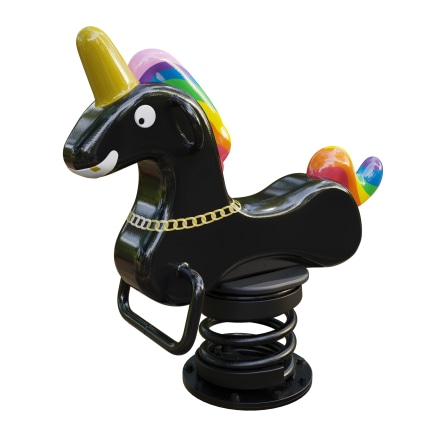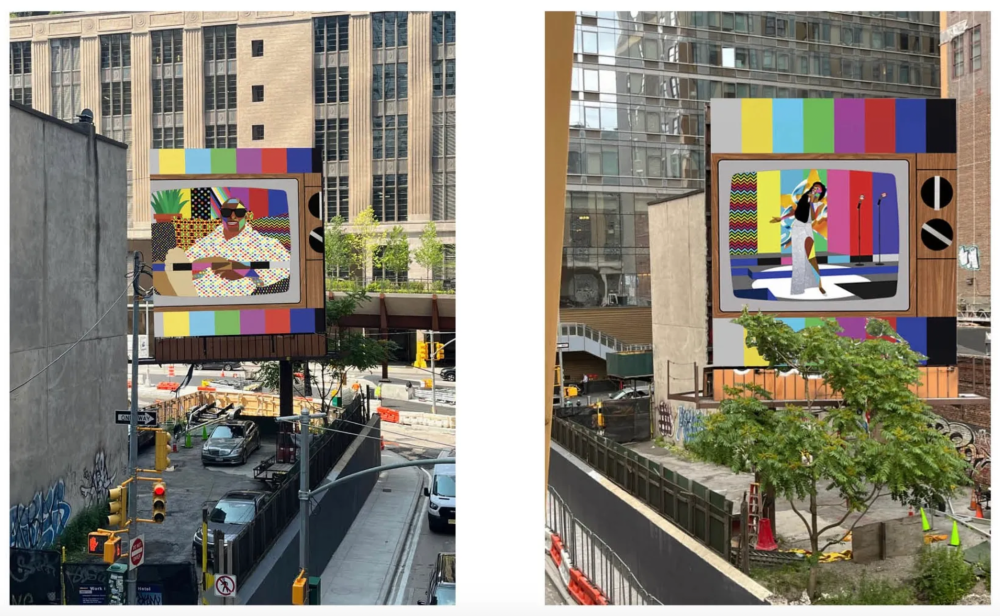

The High Line today announces that two vibrant works by Derrick Adams are now on view on the High Line – Moynihan Connector Billboard, which overlooks the entrance to the Lincoln Tunnel from its location on Dyer Avenue between 30th and 31st Streets. The unique double-sided vertical billboard features two commanding depictions of Black people, broadcasting the figures’ warm self-assurance to the park visitors and passersby below. Each side’s figure is set against the Technicolor backdrop of a TV test pattern, suggesting the reset of cultural conventions on television and popular culture at large that took place as Black culture gained greater mainstream representation in the latter 20th century.
“What a pleasure to have Derrick Adams’ unmistakable figures beaming down from the High Line – Moynihan Connector Billboard,” said Cecilia Alemani, the Donald Mullen, Jr. Director and Chief Curator of High Line Art. “Sitting Pretty and Sing It Like You Mean It remind us of the ways Black imagery has shifted in power and meaning in the age of mass media.”
For the High Line – Moynihan Connector Billboard, Adams reproduces two previous prints at large scale, Sitting Pretty (2016) and Sing It Like You Mean It (2016). Both works hail from the artist’s Live and In Color series, which focuses on the pivotal moment between the 1970s and 1990s as national television attempted to more realistically reflect the diversity of its audience. Endemic in this shift in representation, however, was a portrayal of Black personalities as overly dramatized, larger-than-life, and exaggerated. Both Sitting Pretty and Sing It Like You Mean It are framed by vintage wood-grain finish TVs, complete with the classic VHF (Very High Frequency) and UHF (Ultra High Frequency) knobs found in color televisions of the 70s and 80s. Consistent with this theme, Adams has backgrounded both works with bars of color from the Society of Motion Picture and Television Engineers (SMPTE) test pattern, used to calibrate the color balance on TV screens. The artist also borrows this palette to delineate the angular faces of both works’ central figures, which are laid out in cubist geometry.
Sing It Like You Mean It depicts a diva in a glittery gown, performing on what appears to be a TV set stage, such as those used for talk shows or reality TV singing competitions. She is dramatically spotlit from above; her arm reaches out and her head tilts back as she sings. Behind her are two notably vacant microphone stands with disembodied mouths, seemingly mid-song, hovering just above the mic grilles. The background singers have fully metamorphosed, assuming the form of red and blue bars of color.
Sitting Pretty is composed of several vibrant, contrasting patterns that come together to form the trappings of a living room—a couch, pillows, a small houseplant. The work is foregrounded by a man in a loud polka dot robe and wayfarer sunglasses. He smiles through the screen, his eyes hidden by his oversized shades, as he kicks his feet up and lounges on a couch. Though the central figures in both Sitting Pretty and Sing It Like You Mean It are alone, they seemingly command their spaces with confidence and ease.
Derrick Adams is a Brooklyn-based multidisciplinary artist, with a practice that includes painting, sculpture, collage, performance, video, and public installations. Adams’ work is known for its cubist-like, geometric forms that coalesce into colorful, figurative compositions of contemporary Black life and culture. The artist expands the dialogue around these subjects, often depicting moments of normalcy, leisure, joy, perseverance, and success. Embedded in his practice is a fascination with the “structure” of identity—how we see ourselves, how we project ourselves outwardly to the world, how others perceive us, and how media, visual culture, and consumerism seep into and impact each of these constructs. Through his signature collage style, Adams deconstructs and reassembles Black archetypes seen in advertisements, TV shows, music videos, and national news, and in the process, lays bare the inherent cultural and racial stereotypes that are pervasive throughout popular culture.
On display through March 2024, Derrick Adams’ artworks are provided courtesy of the artist and Gagosian.
ABOUT THE ARTIST
Derrick Adams (b. 1970, Baltimore, Maryland) is an artist living and working in New York, New York. Adams has presented his work in major solo and group institutional exhibitions around the world, including FLAG Art Foundation, New York, New York (2023); Cleveland Museum of Art, Cleveland, Ohio (2021–22); Henry Art Gallery, Seattle, Washington (2021); Hudson River Museum, Yonkers, New York (2020); Baltimore City Hall, Baltimore, Maryland (2019); Museum of Contemporary Art, Denver, Colorado (2018); Museum of Arts and Design, New York, New York (2018); Studio Museum in Harlem via Countee Cullen Library, New York, New York (2017); California African American Museum, Los Angeles, California (2017); and Pioneer Works, New York, New York (2016). Adam’s work is in the permanent collections of Baltimore Museum of Art, Baltimore, Maryland; Birmingham Museum of Art, Birmingham, Alabama; Virginia Museum of Fine Arts, Richmond, Virginia; Brooklyn Museum, New York, New York; Metropolitan Museum of Art, New York, New York; Studio Museum in Harlem, New York, New York; and the Whitney Museum of American Art, New York, New York. Adams has received the Louis Comfort Tiffany Award (2009), Joyce Alexander Wein Artist Prize from the Studio Museum in Harlem (2016), Gordon Parks Foundation Fellowship (2018), and Robert Rauschenberg Foundation Residency (2019).
ABOUT HIGH LINE ART
Founded in 2009, High Line Art commissions and produces a wide array of artworks on the High Line, including site-specific commissions, exhibitions, performances, video programs, and a series of billboard interventions. Led by Cecilia Alemani, the Donald R. Mullen, Jr. Director & Chief Curator of High Line Art, and presented by the High Line, the art program invites artists to think of creative ways to engage with the unique architecture, history, and design of the park, and to foster a productive dialogue with the surrounding neighborhood and urban landscape.
For further information on High Line Art, please visit thehighline.org/art.
ABOUT THE HIGH LINE
The High Line is both a nonprofit organization and a public park on the West Side of Manhattan. Through our work with communities on and off the High Line, we’re devoted to reimagining public spaces to create connected, healthy neighborhoods and cities.
Built on a historic, elevated rail line, the High Line was always intended to be more than a park. You can walk through the gardens, view art, experience a performance, enjoy food or beverage, or connect with friends and neighbors—all while enjoying a unique perspective of New York City.
Nearly 100% of our annual budget comes through donations. The High Line is owned by the City of New York and we operate under a license agreement with NYC Parks.
For more information, visit thehighline.org and follow us on Facebook, Twitter, Instagram.
SUPPORT
Lead support for High Line Art comes from Amanda and Don Mullen. Major support is provided by Shelley Fox Aarons and Philip E. Aarons, The Brown Foundation, Inc., and Charina Endowment Fund.
Project support is provided by Suzanne Deal Booth.
Additional support is provided by Neda Young.
High Line Art is supported, in part, with public funds from the National Endowment for the Arts, the New York State Council on the Arts with the support of Governor Kathy Hochul and the New York State Legislature, and from the New York City Department of Cultural Affairs in partnership with the New York City Council, under the leadership of Speaker Adrienne Adams.
@HighLineArtNYC @derrickadamsny